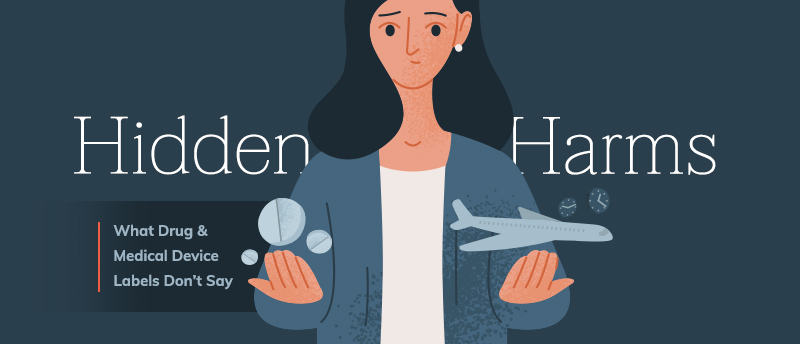Introducing “Hidden Harms” – An Interactive Exploration of Drug and Medical Device Risks

ConsumerSafety.org is pleased to announce the results of a several-month-long investigation into the risks and dangerous side effects hidden within the dense pages of prescription drug and medical device labels.
Click here to investigate the hidden harmsWhat Is a Hidden Harm?
A "hidden harm" is a severe---potentially deadly--unexpected side effect of a prescription medication or medical device. Though all drug and medical device labels contain warnings, most people don't read them. Even when they do, patients have to wade through pages of complicated medical jargon to learn how frequently side effects actually happen.
Furthermore, some drugs and medical devices are approved after short, flawed studies in which side effects are underestimated or completely missed. Certain medical devices are even approved without any human testing at all.
Why Aren't Patients Discussing Side Effects with Physicians?
According to one study, physicians only addressed possible side effects of a new medication in 35% of prescribing encounters. This contrasts sharply with the 76% of patients who want their physician to discuss all possible adverse events associated with a new prescription.
Studies have not yet investigated the interplay between these two opposing facts. But our team speculates that they create the perfect conditions for ignorance of hidden harms. If a majority of patients expect their physician to discuss any and all side effects, but only 35% of them get that discussion, a substantial portion of patients may interpret lack of discussion as a lack of risk.
For all of these reasons, some patients use or receive drugs and medical devices that ultimately cause unanticipated injuries--and even death. They become the victims of hidden harms. At least some of these side effects could be prevented simply by alerting patients to the risks associated with drugs and medical devices.
Uncover the risks hidden in drug and medical device labelsWhat's in the Interactive Data Explorer?
After combing through tens of thousands of adverse event reports and hundreds of clinical trials and studies, we made this important information easier to digest and added some visual aids. Here's what you will find in the interactive data explorer:
- General Drug/Device Information: Brief overview of the drug/device and its intended purpose(s)
- Serious Side Effects: The most serious or surprisingly frequent side effects
- Frequency of Serious Side Effects: How often side effects occurred in studies
- Context: Side-by-side comparisons with everyday risks
In a perfect world, patients would see this information prominently featured on drug and device labels. It would ease the decision-making process by providing clear, understandable statements of fact. We hope to see this simple, engaging information, like that of the Data Explorer, featured in the drug and medical device labels of the future. Until then, the Data Explorer provides useful information for the handful of drugs and devices we cover.
What Can We Learn?
You can glean countless takeaways from the interactive data explorer, but we believe our research has revealed one comprehensive truth:
Drug and medical device risks are not communicated clearly enough for the average patient to make informed health decisions.
We hope our investigation will raise awareness of this problem and encourage changes from patients, physicians and regulators. But how do we know that increased or more transparent communication would effectively decrease injuries caused by bad drugs and medical devices?
We have evidence.
When the FDA became aware of increasing problems with the Essure permanent female sterilization device, they mandated increasing levels of patient education. As patients became more informed of the risks, they chose to use the device less frequently. Sales of the sterilization device decreased so sharply that Bayer chose to pull it from the market just months after the FDA restricted its use to physicians and facilities who used the approved Patient-Doctor Discussion Checklist.
This example demonstrates how patients might be less likely to use risky drugs and medical devices if presented with transparent risk information. In cases where the benefits do outweigh the risks, we believe patients would be more vigilant in monitoring signs of serious reactions. Overall, communicating risks more plainly and prominently would lead to fewer injuries and associated consumer lawsuits.
How Can You Help?
Would you be surprised to learn that almost 10% of Essure female sterilization users are expected to get pregnant within ten years? Does it seem crazy to you that 1 in 20 blood-thinner users experience a life-threatening bleed?
We think so too. That's why it is so important that we raise awareness of these hidden harms today. Here's how you can help:
- Share the Hidden Harms investigation on social media.
- Read drug and medical device labels before you start using them.
- Report adverse side effects from drugs and medical devices.
If you or a loved one were injured by a bad drug or medical device, you should get a free consultation from one of our lawyers today.
Interpreting Data Explorer Information
Our information came from published studies. Real-life experiences with these drugs and medical devices may see higher or lower rates of serious side effects. Even so, these statistics give you a ballpark, real-world estimate of how often people encounter hidden harms.
*Please note: present-tense risk statements do not imply or guarantee that side effects always happen at the rates we found. They are not forecasting future side effects or providing medical advice. These risk statements are for educational purposes only. Any drug or medical device decision should be made with the help of a licensed medical practitioner.
